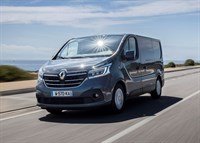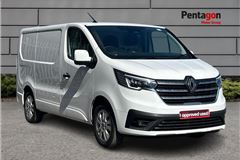Renault Trafic Review 2025
Renault Trafic At A Glance
The latest generation Renault Trafic has been around since 2014, but rather than rest on its laurels Renault has given it a series of updates not once, but twice. It's not common for any vehicle to have two facelifts throughout its life, but as the Trafic is still a competitive model, why throw out the recipe?
In 2019, the Ford Transit Custom rival gained some new 2.0-litre dCi diesel engines replacing the old 1.6-litre units, plus an overhauled interior. In 2022 the engines were tweaked again, while the exterior look was sharpened up and the cabin further updated to keep it modern.
The most important revision from Renault's perspective is the availability of new active safety kit. This is is because, in 2021, Euro NCAP heavily criticised the Trafic and said it is not recommend for its "general lack of safety systems". In response, the 2022 Trafic can be specced with automatic emergency braking, lane keep assist, blind-spot monitoring and traffic sign recognition.
The Renault Trafic is still is offered in numerous configurations, which include panel van, platform cab and nine-seat minibus. Renault also offers a ‘Ready to Work’ range of optional racking systems which are fitted before delivery, meaning owners who need specific kit for work can pick up their new van from the dealer and get right to business.
The Trafic is available in two lengths and two heights and can carry items of up to 3.75 metres (L1 version) or 4.15 metres (L2) in length. Carrying capacity ranges from 5.2 to 8.6 cubic metres, while the load area has a simple-to use through-hatch that allows the loading of planks or pipes.
It can be ordered with an optional interior overhead rack that can carry pipes or a ladder. The van also has 20 anchor points and half sized panel protection as standard. Even the smallest L1 model is capable of carrying three Euro pallets, while the maximum permitted payload weight ranges from 1079kg to 1281kg, depending on size and engine choice.
Under the bonnet, the Trafic was launched with a range of 1.6 turbodiesels with 90PS or 115PS, while fuel economy for both peaked at an official 43mpg. The best engine, however, is the twin-turbo 1.6 with 120PS or 140PS and economy of up to 47mpg. For heavy work the twin-turbo engines are best, with most of their torque available from just 1250rpm.
The 1.6 dCi diesels were phased out in 2019 and replaced with 2.0 dCi engines as part of an extensive midlife update - these are more efficient and quieter, while the larger engine means even better low-down torque. These engines became 'Blue dCi' units in 2022, with four outputs options ranging from 110PS to 170PS.
The interior was extensively improved in 2019 with a new dashboard and much more supportive seats. That changed again in 2022 with Renault bringing in a new infotainment screen and rotary dials like you get in the latest Clio. These changes make the Trafic a much stronger rival to the likes of the Transit Custom.
The cabin is reminiscent of the current Renault car range, with decent quality materials and a comfortable, MPV-style driving position. Renault has also given significant emphasis to the ‘mobile office’ theme, with a dash mounted cradle for a mobile phone or tablet PC. The centre seat can also be transformed into a laptop holder and there is a built in, removable clip board that can be directed at the driver or passenger.
Driving the Renault Trafic
The Renault Trafic is offered with a comprehensive range of engines. Initially, from launch, the Trafic was offered with a 1.6-litre diesel, with outputs ranging from 90PS to 140PS. However, Renault expanded the line-up with Euro 6 diesels in 2016. These then morphed into the 2.0-litre dCi and Blue dCi units in 2019 and 2022 respectively.
For older vans, the twin-turbo versions of the 1.6 dCi are by far the best. Not only do they pull strongly from low revs, but they make driving easier thanks to their broad torque output. Less impressive, however, are the sluggish 1.6 dCi engine that uses a single turbocharger and produces 90PS/95PS and 260Nm of torque.
The torque delivery makes the twin-turbo engines very tractable and easy to drive. Unlike other engines, you do not have to change down through the gears as often, which makes it a lot easier to haul heavy loads. The twin-turbo engines are also ideal for motorway work and long distance, not only because of the power delivery but because of the refinement levels, which are quiet and on par with a passenger car.
The 2016 updates also saw Renault introduce the Energy dCi 95PS engine for the first time. Depending on bodystyle, the four-cylinder powertrain will return up to an official 46mpg and 260Nm of torque from 1500rpm. However, truth be told, the 95PS version seldom feels up to the task of heavy duty load moving or towing, struggling to get up to speed.
The Trafic van was comprehensively updated in 2019, with the 1.6 dCi being phased out in favour of Renault's 2.0 dCi. The 2.0-litre diesel uses a variable geometry turbocharging to develop more power and (more significantly) better low-gear pull under heavy loads. There was a choice of 120PS, 145PS or 170PS, with the entry-level 95PS Trafic being axed from the line-up.
The Blue dCi units of 2022 are largely the same mechanically, with AdBlue injection to reduce emissions. The power outputs were changed giving four options: 110PS, 130PS, 150PS or 170PS.
The benefits of the 2.0-litre engine are immediately obviously from behind the wheel, with smoother power delivery at urban speeds and lower levels of engine noise on the motorway. Buyers also get the choice of a six-speed manual or dual-clutch six-speed auto.
For the 2022 model we drove the entry-level 110PS unit mated to the six-speed manual. We reckon it'll just about suffice most people's needs, with acceptable pulling power, refined cruising and a nice spread of torque. Those regularly carrying heavy loads will want to upgrade to the higher-powered units such as the 130PS engine, however, particularly as it has the same quoted economy figure. The manual shift is decent enough, but not outstanding.
Regardless of which engine you choose, the Trafic is always easy to drive. The driving position is much like that of a family MPV, with good forward visibility and plenty of adjustment. The mirrors are large and offer a clear view back, plus there is a wide-angle mirror built in the passenger sun visor to help with visibility at oblique junctions. It’s a clever, simple solution to a problem many van drivers face regularly.
The steering is nicely weighted, too, meaning you have confidence that it'll go where you point it. Ride quality is good, regardless of the amount of weight being carried, although the wheels do thud over larger road imperfections. Like many bigger vans you'll find some steering correction needed at motorway speeds as the van is attacked by crosswinds, but it's not too bad.
There’s a good amount of technology to assist the driver, including an electronic differential to improve traction on loose surfaces like you might find on a muddy building site. There’s also a hill start assistance system that saves using the hand brake, plus a trailer stability control programme to reduce trailer sway.
In 2022, Renault finally embraced active safety kit with a suite of systems available. Sadly all of these, even including automatic emergency braking, are optional equipment. But at least you now have the choice, and none of the systems are particularly intrusive from our experience.
Renault Trafic interior
The load area in the Trafic is much the same as its predecessor, which is by no means a bad thing – it means racking systems and other accessories that were designed for the previous model will fit into the new one with no modification. There have been some important tweaks, though, including a slightly longer load area that can now accommodate three Euro pallets even in the shortest L1 version.
As before there are a number of configurations on offer, with the choice of the panel van in two lengths and two heights, all with a full metal bulkhead.
There’s also a nine-seat minibus, should you want it. Admittedly, it isn’t particularly plush or luxurious compared to something like a Mercedes-Benz Vito, but it offers plenty of space in both passenger rows along with a sizeable load area. We think it would make an ideal airport taxi.
For the vans, load volumes vary between 5.2 - 8.6 cubic metres. L1 and L2 crew cab versions are offered too, with respective load volumes of 3.2 and 4.0 cubic metres. The Trafic lacks the heavy duty payload capacity of its rivals, like the Transit Custom and Vivaro, however, with weight peaking at 1240kg, depending on size and engine choice. In comparison the Ford and Vauxhall will carry up to 1400kg.
In the load area there’s a simple-to use through-hatch that lets you load longer items either under the passenger seat or right to the very front of the cab. It allows the loading of planks or pipes up to 3.75m in the shorter L1 variant, with 40cm of extra load length in the longer L2. The hatch is very easy to operate intuitively, although it's heavily sprung and might trap fingers for the first few weeks.
Another clever touch is a system that allows you drive with one of the rear doors partially open. The system ensures you stay legal, with visible tail lights and a number plate, but improves the van’s flexibility to carry oversized items from time to time. There’s also an internal roof mounted rack system on offer that allows you to carry a ladder or piping away from the van floor, freeing up space.
Renault has made the cabin very work-friendly. On versions with three front seats there is a laptop storage area in the middle seat back, along with a built-in removable clip board, plus mounting points for smartphones or iPads. There are two different touchscreen infotainment systems on offer, both of which are easy to use. Renault is also offering an optional app for mobile phones and tablets, which links to the van's computer and lets the driver analyse fuel consumption and trip data.
There are numerous cubby holes for odds and ends including a pair of covered glove boxes, several drinks holders, plus hangers for coats or work clothes. The cabin itself is very comfortable and car-like, with excellent levels of refinement and adjustment for the seats. Indeed it’s so quiet and comfortable it’s easy to forget that you’re even driving a van a lot of the time.
There are problems, though. The pleasant dash covering feels solid except for in the area where the passenger airbag is mounted. Here the plastic covering is alarmingly thin - putting feet up or messing around with a heavy item would likely damage it. Furthermore, passenger seating is tight in variants with three front seats, while the phone bracket provided is a tight fit for larger smartphones. The door pockets are also narrow.
In 2019, Renault launched the revised Trafic which addresses many of these issues. The quality of the interior is much improved and there are details like chrome inserts on the air vents, to give it a more upmarket feel and a nicer to use gear lever.
Although that doesn't apply to the base Business edition, with its dull black plastics and lack of standard air-con. The latter is still commonplace on entry-level trim levels, but it feels a bit mean in 2022. You want at least Business+ spec unless you're really on a budget.
Sadly we've not yet tried the updated 2022 infotainment, but a similar system is available on entry level versions of Renault's Clio and Captur family car and it's a much more responsive unit than the old system. Renault sent us a base model Trafic with a simple DAB radio setup and a monochrome screen, although it's easy to use and comes with Bluetooth connectivity.
The 2019-on Trafic is far quieter on the move thanks in part to the new engines plus a new windscreen designed to minimise wind noise and vibrations. The biggest change is one you won't immediately spot - the seats. They've been redesigned and are now firmer with more support, which driver's who spend all day behind the wheel will certainly appreciate. We spent a good few hours at the wheel and there were no comfort issues.
Renault Trafic models and specs
| Dimensions | |
|---|---|
| Length | 4999–5399 mm |
| Width | 1956 mm |
| Height | 1971 mm |
| Load Volume | 3.2–4.0 m3 |
| Miscellaneous | |
|---|---|
| Kerb Weight | 1661–1691 kg |
| Payload | 975–1060 kg |
| Warranty | 4 years / 100000 miles |
| Servicing | 25000 |
Panel Crew Van 6 Seats LWB
| Version | List Price | MPG | |
|---|---|---|---|
| Business LWB Low Roof 6 Seats LL29 dCi 115 | £22,095 | 42.8 mpg | Details |
| Business LWB Low Roof 6 Seats LL29 Energy dCi 120 | £22,695 | 46.3 mpg | Details |
| Business LWB Low Roof 6 Seats LL29 Energy dCi 140 | £23,295 | 45.6 mpg | Details |
| Business+ LWB Low Roof 6 Seats LL29 dCi 115 | £23,195 | 42.8 mpg | Details |
| Business+ LWB Low Roof 6 Seats LL29 Energy dCi 120 | £23,795 | 46.3 mpg | Details |
| Business+ LWB Low Roof 6 Seats LL29 Energy dCi 140 | £24,395 | 45.6 mpg | Details |
| Sport LWB Low Roof 6 Seats LL29 dCi 115 | £24,395 | 42.8 mpg | Details |
| Sport LWB Low Roof 6 Seats LL29 Energy dCi 120 | £24,995 | 46.3 mpg | Details |
| Sport LWB Low Roof 6 Seats LL29 Energy dCi 140 | £25,595 | 45.6 mpg | Details |
Panel Crew Van 6 Seats MWB
| Version | List Price | MPG | |
|---|---|---|---|
| Business SWB Low Roof 6 Seats SL29 dCi 115 | £21,395 | 43.5 mpg | Details |
| Business SWB Low Roof 6 Seats SL29 Energy dCi 120 | £21,995 | 47.9 mpg | Details |
Panel Crew Van 6 Seats SWB
| Version | List Price | MPG | |
|---|---|---|---|
| Business SWB Low Roof 6 Seats SL27 dCi 115 | £20,895 | 43.5 mpg | Details |
| Business SWB Low Roof 6 Seats SL27 dCi 90 | £20,395 | 43.5 mpg | Details |
| Business SWB Low Roof 6 Seats SL27 Energy dCi 120 | £21,495 | 47.9 mpg | Details |
| Business SWB Low Roof 6 Seats SL27 Energy dCi 140 | £22,095 | 46.3 mpg | Details |
| Business SWB Low Roof 6 Seats SL29 Energy dCi 140 | £22,595 | 46.3 mpg | Details |
| Business+ SWB Low Roof 6 Seats SL27 dCi 115 | £21,995 | 43.5 mpg | Details |
| Business+ SWB Low Roof 6 Seats SL27 Energy dCi 120 | £22,595 | 47.9 mpg | Details |
| Business+ SWB Low Roof 6 Seats SL27 Energy dCi 140 | £23,195 | 46.3 mpg | Details |
| Sport SWB Low Roof 6 Seats SL27 dCi 115 | £23,195 | 43.5 mpg | Details |
| Sport SWB Low Roof 6 Seats SL27 Energy dCi 120 | £23,795 | 47.9 mpg | Details |
| Sport SWB Low Roof 6 Seats SL27 Energy dCi 140 | £24,395 | 46.3 mpg | Details |
Model History
- April 2014: New Trafic unveiled
- October 2014: R&GO app launched
- July 2016: Renault Trafic gets more power with Euro 6 engines
- April 2018: Renault vans now available with supplied sign writing
- November 2018: Trafic Premier Edition launched
- April 2019: 2019 Trafic van launched
April 2014
New Trafic unveiled
Under the bonnet the Trafic gets a new 1.6 turbodiesel that can be specified with 90PS or 115PS. Fuel economy for both units is a claimed 43.5mpg, while emissions is 170g/km of CO2. Renault is also offering a twin-turbocharged version of the 1.6-litre engine - 120PS and 140PS - and significant improvements in economy, with up to 47.9mpg available.
Other upgrades include a revamped interior, new seats, dashboard and trim. Renault has also given significant emphasis on the ‘mobile office’ theme, with a dash mounted cradle for a mobile phone or tablet PC. The centre seat can also be transformed into a laptop holder, thus allowing the driver to transform the cab into a mobile office.
The Trafic is available in two lengths and two heights and can carry items of up to 3.75 metres (L1 version) or 4.15 metres (L2) in length. C arrying capacity ranges from 5.2 to 8.6 cubic metres, while the load area has a simple-to use through-hatch that allows the loading of planks or pipes. The Trafic can also be ordered with an optional interior overhead rack that can copper pipes or a ladder. The van also has 20 anchor points and half sized panel protection as standard.
Thanks to a slightly increased wheelbase the L1 model is now capable of carrying three Euro pallets while the maximum permitted payload weight ranges from 1079kg to 1281kg, depending on size and engine choice.
October 2014
R&GO app launched
The app can be downloaded for free onto both iPhone and Android, although the navigation costs £19.99. It connects to the vehicle via Bluetooth and gives 3D turn-by-turn navigation.
The app includes a vehicle trip computer, giving the driver’s eco rating and fuel economy figures, plus functions including internet radio and music playback. There are also telephone commands, allowing the driver to make hands free calls and have text messages read out loud.
With the phone mounted on the dash, drivers can use the touchscreen to access music or control their FM radio through the app. The navigation includes UK and Ireland mapping and live traffic alerts. The mapping is downloaded and stored on the phone, enabling GPS navigation without using mobile data.
While the app is free, the navigation feature costs £19.99, made through the app. A one-month free trial is available.
July 2016
Renault Trafic gets more power with Euro 6 engines
Utilising a Selective Catalytic Reduction (SCR) system and Adblue, the Trafic’s range of Euro 6 engines are more powerful than their Euro 5 predecessors by 5PS. These encompass the single turbo dCi 95 and dCi 120 engines, together with the twin turbo Energy dCi 125 and Enerygy dCi 145 engines.
April 2018
Renault vans now available with supplied sign writing
Ordered at the same time, or soon after, the van sale is completed, the sign writing is created within three standard templates. These allow the customer to add their logo, expertise/services offered, a website address and business telephone number. Font type and colour can also be specified. The signs are for the each side of the van and the rear doors or tailgate.
Package 1 - Sides and rear. Choice of 10 x fonts and 10 colours. Company name / Services description / Tel number / Website. Positioning of elements as pre-defined. Pricing – Kangoo £215 ex VAT, Trafic £275 ex VAT, Master £360 ex VAT
Package 2 - Sides and rear. Choice of 10 x fonts and 10 colours. Company name / Services description / Tel number / Website / Logo sides and rear. Positioning of elements as pre-defined. Kangoo £270 ex VAT, Trafic £350 ex VAT, Master £435 ex VAT
Package - Sides and rear. Unlimited Choice of fonts/. Company name / Services description / Tel number / Website / Logo sides and rear logos. Positioning of elements as pre-defined. Kangoo £360 ex VAT, Trafic £450 ex VAT, Master £535 ex VAT
November 2018
Trafic Premier Edition launched
Based on the Sport Nav, Premier Edition versions get black alloy wheels and a choice of black or white decals, plus such standard features as auto headlights and wipers, front fog lights and cruise control. For convenience and safety, all the Premier Edition Renault vans include the R-Link Infotainment system with TomTom navigation, a rear view camera and, a dash cam with ADAS (Advanced Driver Assistance System).
Body-coloured side mouldings and 17-inch ‘CYCLADE’ black alloy wheels are exclusive to the Renault Trafic Premier Edition. It offers a choice of two wheelbases, plus the availability of a Crew Van version, and can be ordered with the 1.6-litre turbodiesel engine in either dCi 120 , ENERGY dCi 125 or ENERGY dCi 145 specification. The Renault Trafic Premier Edition is priced from £26,150 excluding VAT.
April 2019
2019 Trafic van launched
Updated Renault Trafic is a revamped van offering a new interior and exterior design with new 2.0 engines and EDC6 automatic gearbox.
The cabin is revised with an updated dashboard with satin chrome buttons (air vents, circling of the centre console, air conditioning control, gear lever and meters) and a dark carbon colour scheme. The design extends to the door panels (chrome door opening levers and trim on speakers for PV versions).
The load area gets LED lighting (500 lumens) of the loading area for better working conditions, a new three-button folding key or a Renault hands-free card with Single Door Opening (SDO) option for improved safety, with optional additional Extra Security lock still offered and a new polypropylene lining of the loading area for easier cleaning (optional), with a comprehensive choice of tailor-made lining providing a more robust and long-lasting loading area.
2019 Trafic features a range of 2.0L dCi engines even more suited for business customers. These engines now comply with Euro 6d-TEMP standards. With a variable-geometry turbocharger, the engines achieve greater power from 120 to 170 hp and increased torque up to 380 Nm.
Another update: On the two with higher power outputs, these engines can now be coupled, in addition to a manual gearbox, to a six-speed EDC (Efficient Dual Clutch) automatic transmission, allowing for smoother and faster gear shifting. They always include the latest pollution-control technologies, like the selective catalytic reduction system (SCR).
Full LED headlamps also improve safety at night, increasing lighting by 50% when lights are in full-beam position and by 34% in dipped-beam position, compared with halogen headlamps.

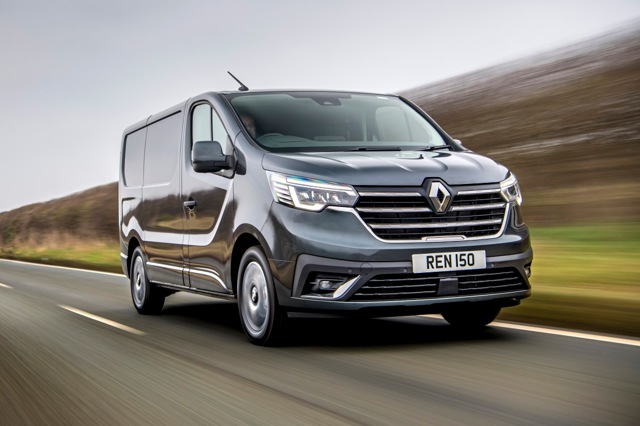


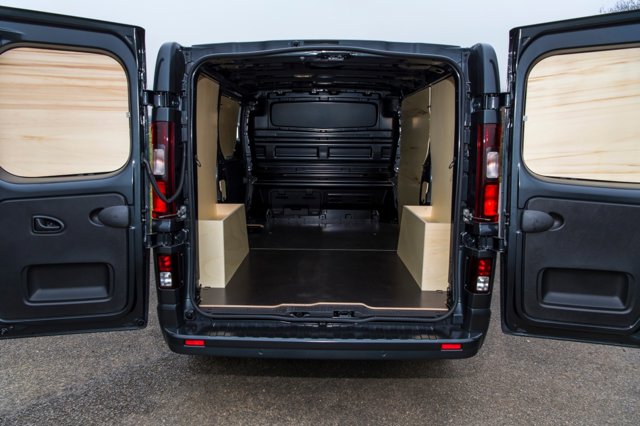
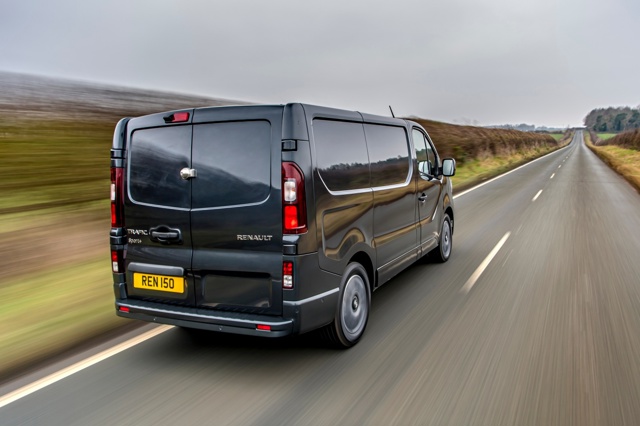

![2025 Renault Trafic SL30 Blue dCi 150 Extra [Safety] Van](http://images.honestjohn.co.uk/imagecache/url/crop/150x100/https/cdn.uk.prod.group-mobility-trader.com/images/cas/6810753831689c312328126328c19a03/b9688527c6720d93f41a14401c76615b.jpg)

 Refined and comfortable, L1 capable of carrying three Euro pallets, new 2.0 dCi from 2019 is quiet and punchy, 2022 update improves safety.
Refined and comfortable, L1 capable of carrying three Euro pallets, new 2.0 dCi from 2019 is quiet and punchy, 2022 update improves safety.
 Can't match its key rivals for outright payload, technically not an all-new van rather a thorough revamp of the previous model, base model has no air-con even in 2022.
Can't match its key rivals for outright payload, technically not an all-new van rather a thorough revamp of the previous model, base model has no air-con even in 2022.
